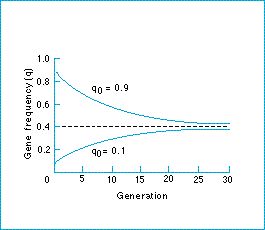The theory of natural selection (part 2) - What are the effects of migration?

Why does migration unify gene frequencies between populations?
Consider the case of two populations and one locus with two alleles (A and a ). Suppose this time that one of the populations is much larger than the other, say population 2 is much larger than population 1; then practically all the migration is from population 2 to population 1. The frequency of allele a in population 1 in generation t is written q1(t); we can suppose that the frequency of a in the large population 2 is not changing between generations and write it as qm.
Now, if we pick on any one allele in population 1 in generation (t + 1), it will either be descended from a native of the population or from an immigrant. Define m as the chance that it is a migrant gene. (Earlier in the tutorial, m was used for the mutation rate: now it is the migration rate.) If our gene is not a migrant (chance (1-m)) it will be an a gene with chance q1(t), whereas if it is a migrant (chance m ) it will be an a gene with chance qm . The total frequency of a in population 1 in generation (t + 1) is
q1(t+1) = (1-m)q1(t) + mqm
This can be rearranged to show the effect of t generations of migration on the gene frequency in population 1. If q1(0) is the frequency in the 0th generation, the frequency in generation t will be
q1(t) = qm + (q1(0) - qm)(1-m)t
(From t = 1 it is easy to confirm that this is indeed a rearrangement of the previous equation.)
The equation says that the difference between the gene frequency in population 1 and population 2 decreases by a factor (1-m ) per generation. At equilibrium, q1 = qm and the small population will have the same gene frequency as the large population (data). Similar arguments apply if, instead of there being one source and one recipient population, the source is a set of many subpopulations, and pm is their average gene frequency, or if there are two populations both sending migrants to, and receiving them from, another.
Figure: a source population with gene frequency qm = 0.4 sends migrants to two subpopulations with initial gene frequencies of 0.9 and 0.1. They converge, with m = 0.1, onto the source population's gene frequency in about 30 generations.
| Next |



